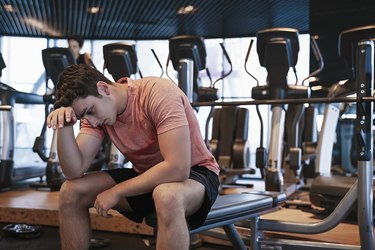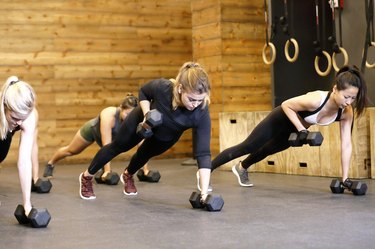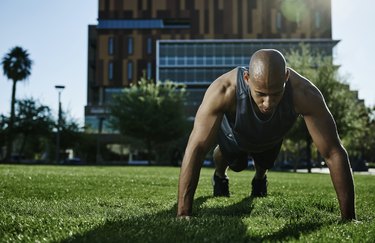
Many of us have experienced the dreaded headache during exercise. You start your run or gym session and, boom, it hits you. It might feel like a dull ache, a sharp pain or unbearable pressure. No matter how it presents itself, it interrupts your routine and you're forced to take your throbbing head home.
First of all, if this has just happened to you, don't panic. We talked to board-certified headache medicine specialist Christopher Rhyne, MD, who says that while there is always a chance that getting a headache while working out could have a more serious cause, most of the time they're fairly benign. Still, it's painful. And if you encounter exertion headaches (sometimes called exercise headaches) on a regular basis, it can be super frustrating.
Video of the Day
Video of the Day
You're probably wondering why you're getting a pounding headache while you're doing something that is supposedly good for your health. Well, good news there — your workout isn't always to blame.
"It's important to know that just because you get a headache while you're exercising, particularly if it's outside, it doesn't mean it's the exercise," Dr. Rhyne, director of clinical research and staff physician at the Diamond Headache Clinic, says. "There may be other factors associated with it."
With the help of Dr. Rhyne and some research, we have answers and advice to help remedy the pain you're feeling. Here are six reasons why you might get a headache while exercising and how to fix it.
First, What Is a Headache?
A headache is defined as pain or discomfort in your head or face, according to the Cleveland Clinic. About 40 percent of people worldwide experience tension headaches on a regular basis, which is the most common type, and 96 percent of people have experienced a headache at least once in their lives.
For such a ubiquitous condition, there are a lot of variables when it comes to causes, types and body parts involved. According to Johns Hopkins Medicine, there are nerves on your scalp, face, mouth and throat that could play a role in the pain. Then there are muscles in your jaw, head, neck and shoulders. Finally, the pain could be coming from blood vessels around your brain. There are more than 150 different types of headaches, per the Cleveland Clinic.
To organize all these types, doctors and researchers have categorized these headaches into two groups: primary and secondary headaches. The American Journal of Medicine defines a primary headache as one having no underlying cause. A secondary headache, then, is the result of some other condition causing pain. These are caused by infection, trauma or vascular disease.
Most of the headaches that fitness enthusiasts are dealing with are primary headaches, according to Dr. Rhyne. The symptoms of a primary headache related to exercise are a throbbing sensation and pain on both sides of your head that comes on during or after exercise, according to an April 2o20 review in Current Neurology and Neuroscience Reports.
If you experience these symptoms along with vomiting, double vision, neck stiffness or a loss of consciousness, there is a chance this is a secondary headache, and you should call your doctor or go to the emergency room.
"When we talk about exercise, a tension headache and a migraine headache are really the most common headaches people will experience," Dr. Rhyne says.
Migraine vs. Tension Headache
Migraines are misunderstood and underdiagnosed despite being a leading cause of disability in the world, according to a December 2020 editorial in The Journal of Headache and Pain. They are quite painful and disproportionately affect women more than men.
"There are 40 million Americans that deal with migraine, 85 percent of those are women and most of them are women in their reproductive years," Dr. Rhyne says.
Many people think that a migraine means you have to have extreme pain and must be groaning in a dark cave, but Dr. Rhyne says that's not necessarily the case.
"To be considered a migraine, it has to last for at least four hours in adults and have some associated symptoms with it — not just the headache pain itself, but a little nausea or a little light sensitivity or sound sensitivity,'" Dr. Rhyne says. "Just because over-the-counter medications treat it doesn't mean it's not a migraine."
When it comes to working out, Dr. Rhyne says when a headache comes on during exercise and only gets worse, it could be a migraine. Also, if it comes hours after exercise, that might be a migraine too.
If you're reading this and realizing you might have been experiencing migraines this whole time, know that there are both acute and preventative options — both in the form of medicine and not — that are just one doctor's appointment away. Plus, we'll go through what might be causing them to disrupt your workout routine below.
If you experience head pain alone, it's likely a tension headache. These are caused by many different factors, including exercise alone and other variables you encounter while you're exercising.
"Tension headaches can be triggered by physical activity," Dr. Rhyne says. "Maybe you start lifting or start running and when you first get going, you kind of kick off a headache. But you might notice that as you run through it or as you work out through it, it gets better."
While that's great, it would be nice to know the answer to the question, "How do I stop exertion headaches when working out?" once and for all. So, let's jump into the reasons and get some solutions.
Why You Get a Headache While Exercising
1. Physical Exertion
Okay, so it might seem obvious that when you're exercising, you're working hard. Well, guess what? That might be why you're experiencing an exertion headache.
To understand an exercise headache, Dr. Rhyne explains that you need to know what happens in your body when you start working out.
"Our blood pressure goes up, our body temperature goes up, we start dumping a bunch of hormones. But the big piece of this is you have this really sudden onset of increased intracranial pressure," Dr. Rhyne says.
Why does this happen? Scientists who've studied primary exercise headaches, like in the Current Neurology and Neuroscience Reports review, believe it happens because our arteries expand to allow more blood flow. The sudden increase in blood pressure creates pressure in your skull, causing that throbbing sensation.
"So, think about doing a squat: That feeling of bearing down and gutting it out, that sensation increases the blood supply being held in our brain," Dr. Rhyne says.
While expanding veins and blood flooding your brain may sound scary, it's usually nothing but overexertion. The best way to prevent this type of headache is to avoid the movement that causes it, especially if it's a reoccurring issue. But if that's not possible, Dr. Rhyne says to visit your doctor to talk about pre-treatment in the form of NSAIDs or other medications.
There's also a chance that exertion might bring on a migraine.
"We're causing this intermittent increase in intracranial pressure," Dr. Rhyne says. "And for people who don't deal with headache conditions, not a big deal. But for people who are prone to developing pain as a consequence of that negative stimuli, they can develop an onset, particularly of migraine, in the presence of that increased pressure."
2. Environmental Factors
Exercise is not usually the primary cause of your headache. Often, you're dealing with environmental stuff in conjunction with heavy breathing and intense movement — and that's what brings on a massive headache. Here are the common culprits:
Allergies
"If you go for a run in the dead of winter and you do great, but then you go for a run in the spring when the trees are blooming and you get a killer headache, it's most likely sensitivities to environmental allergens," Dr. Rhyne says.
This is usually easily managed. He says to try taking an over-the-counter allergy medicine before you go outside to see if that manages the problem. If that doesn't help, visit your primary care physician or an allergist to discuss other medication options.
Altitude
When you're at higher elevations, there is less oxygen. The air is thin, it's harder to breathe and it can make you feel weird.
"So, if you are used to running on the beach in Tampa and you visit Utah and try to run, you might get a level of hypoxia," says Dr. Rhyne.
That means, your body's blood and tissues have lower levels of oxygen. This can cause symptoms like restlessness, anxiousness, dizziness and — you guessed it — headaches.
Most of the time, you won't get so hypoxic as to get sick if you're under 8,000 feet, according to the National Health Service, but even being at 4,000 feet can be bothersome to people who aren't used to it. The best way to combat any sort of altitude sickness is to ease into physical activity at higher elevations, give your body a few days to adjust and stay hydrated.
Weather
Hot conditions, cold temperatures, dry air, and even subtle changes in barometric pressure can lead to headaches, per a December 2015 report in SpringerPlus. Summer exercise headaches are probably the most common.
"For many people, it's not the exercise, it's the heat," Dr. Rhyne says. "Not only are we increasing our core body temperature while we exercise, but our metabolic demand goes up."
That, coupled with an increased risk of dehydration or, for those who experience migraines, sensitivity to the sun, can be the perfect storm for a headache to show up.
Dr. Rhyne says the best remedy for weather-related headaches is prevention. He recommends exercising in the coolest part of the day in the summer, dressing warmly in winter and paying attention to if a storm is rolling in so you can avoid working out as the pressure in the air is changing.
3. Improper Fueling
When it comes to keeping headaches at bay, water and food are kind of no-brainers. You may also be inadvertently causing your noggin to pound by taking a supplement.
You're Dehydrated
The advice is widespread — hydrate before physical activity to avoid dehydration and its related symptoms, like head pain. So, can dehydration cause exertion headaches? Yes. The exact reason why dehydration causes headaches is unknown, according to Harvard Health Publishing. But the hypothesis is that fluid shifts out of your brain when you're dehydrated, which creates traction on the lining of the brain, which then could turn your pain receptors on.
To avoid this, drink water throughout the day and have a sports drink 30 minutes to an hour before intense activity, especially in hot weather. Also, don't forget to drink while you work out.
You Didn't Eat Enough
Hunger headaches are real. If you're skipping meals, not getting enough calories and then going out and burning through the little reserves you have left, you'll likely end up with a dull ache in your head.
The Cleveland Clinic explains why your head hurts when you're hungry: Your blood sugar drops and stress hormones are released, which can cause a nasty headache. You may also experience hypoglycemia for the same reason.
To prevent the onset of a hunger headache during your workout, make sure you are eating nutritious meals throughout the day.
You're Taking a Pre-Workout Supplement
Dr. Rhyne says many pre-workouts on the market contain ingredients that can cause headaches. Even the most seemingly harmless ingredient — caffeine — could trigger a migraine if you're predisposed, he says.
Some pre-workouts contain nitric oxide, which Dr. Rhyne says is great unless you have a tendency toward headaches.
"There's nothing wrong with naturally occurring nitric oxide," he says. "The problem is that it dilates the blood vessels, and when we get that big dilation, we can promote migraine headaches. In a clinical setting, when we try to inspire headaches to see how we can fix them, we give people nitroglycerin."
Another ingredient to watch out for is tyrosine.
"People will take tyrosine and become histaminergic with it, meaning many pre-workouts promote this histamine response," Dr. Rhyne says. This can trigger a headache.
4. Hormones
Many people who experience migraines regularly know all too well that menstruation can bring on a terrible episode. A "menstrual migraine" can occur about two to three days before your period, and it can also be triggered by exercise, Dr. Rhyne says.
One option is to take it easy in the days leading up to your period. But if you're training for a specific goal or just don't want to do that, there is good news. It might be something you can prevent if you know it's coming.
"If you're going to go for a run and you're a couple of days from your period and you notice when you're exercising that you're more likely to have this headache presentation, you can treat it ahead of time," Dr. Rhyne says. "There are prescription-strength medications that we can use in those situations."
So, track your headaches and see if it's following this pattern, then talk to your doc.
5. Overtraining or Stress
There is such a thing as working out too much or exercising beyond your current fitness level. When the load becomes too great and your recovery time is too short, you run the risk of developing overtraining syndrome.
Aside from headaches during exercise, these are the signs of overtraining syndrome according to the Hospital for Special Surgery.
- Decline in athletic performance
- Muscle soreness and heaviness
- General fatigue
- Poor sleep
- Increased blood pressure and resting heart rate
- Increased tension
- Restlessness
- Illness
Headaches might just be one piece of the symptom puzzle, but it's important to pay attention if it's happening regularly. Not recovering enough is a big deal that can affect every part of your body.
The other thing to know is that stress from other parts of your life — work, school, family and social demands — can hinder your recovery and lead to overtraining syndrome. It's important to monitor yourself to make sure your body can handle what you're asking it to do.
So, that little headache on a training day might be trying to tell you something. If you suspect you're on the brink of overtraining, slow down. Supplement your workout days with rest days and time for meditation and relaxation. We know, easier said than done. But if you make it a point and actually schedule time off your feet, you'll be more likely to follow through.
6. Something More Serious
Headaches during exercise could mean there is an underlying condition causing the pain that needs to be addressed.
Emergency conditions like a subarachnoid hemorrhage, or bleeding in the space that surrounds the brain, will cause symptoms like blurred vision, loss of consciousness, vomiting, neck stiffness, trouble speaking, a drooping eyelid and seizures, per Johns Hopkins Medicine.
Cerebral aneurysms rarely cause headaches unless they have burst, per Johns Hopkins Medicine, which would essentially cause the worst headache of your life. If you are at all worried about one of these serious conditions, head to the emergency department now. If it's actually a migraine masquerading as something worse, it's better to be safe than sorry.
Even if you're not dealing with extreme symptoms, Dr. Rhyne says it's a good idea to talk to your doctor if your exertion headaches are frequent enough for you to be bothered by them. He also says brand new types of headaches don't usually occur later in life, so if you're having headaches when you have not before, check in with your doctor.
What Kind of Doctor Should You See for Chronic Exertion Headaches?
Your primary care physician is a good first step. They may refer you to a neurologist, depending on your condition.
If exercise headaches or migraines are a concern for you, Dr. Rhyne suggestions seeing if there is a board-certified headache specialist near you. There are unfortunately only 600 trained physicians in this specialty right now in the U.S., but you can search for one by zip code at the American Migraine Foundation website.
If you can't afford health care, you can find low-cost options in your community through HealthCare.gov.
The Bottom Line
Generally speaking, headaches are just a part of human existence, unless you are one of the lucky few who won't experience one in your lifetime.
The best way to prevent exercise-induced headaches is to learn your triggers and work to avoid them. If you're having a hard time knowing what causes your headaches, keep a journal to see if there's a common theme.
And finally, don't forget to eat well, stay hydrated, slow down and lift a little lighter some days. Your cranium will thank you.
- National Headache Foundation: "Exertional Headaches"
- Medline Plus: "Subarachnoid Hemorrhage"
- The American Journal of Medicine: "Headache"
- Harvard Health Publishing: "Can dehydration cause headaches?"
- American Migraine Foundation: "Find a Doctor"
- Johns Hopkins: "Cerebral Aneurysm"
- Johns Hopkins: "Subarachnoid Hemorrhage"
- Cleveland Clinic: "Headaches"
- Johns Hopkins Medicine: "Headaches"
- Current Neurology and Neuroscience Reports: "Primary Exercise Headache"
- The Journal of Headache and Pain: "Migraine remains second among the world’s causes of disability, and first among young women: findings from GBD2019"
- National Health Service: "Altitude Sickness"
- SpringerPlus: "Examination of fluctuations in atmospheric pressure related to migraine"
- Cleveland Clinic: "Hunger Headache"
- Hospital for Special Surgery: "Overtraining: What It Is, Symptoms, and Recovery"
- Hagan KK, Li W, Mostofsky E, Bertisch SM, Vgontzas A, Buettner C, Mittleman MA. Prospective cohort study of routine exercise and headache outcomes among adults with episodic migraine. Headache. 2021
- Amin FM, Aristeidou S, Baraldi C, Czapinska-Ciepiela EK, Ariadni DD, Di Lenola D, Fenech C, Kampouris K, Karagiorgis G, Braschinsky M, Linde M; European Headache Federation School of Advanced Studies (EHF-SAS). The association between migraine and physical exercise. J Headache Pain. 2018
- Update on headaches associated with physical exertion
- Dr. Christopher Rhyne, phone interview
Is this an emergency? If you are experiencing serious medical symptoms, please see the National Library of Medicine’s list of signs you need emergency medical attention or call 911.


